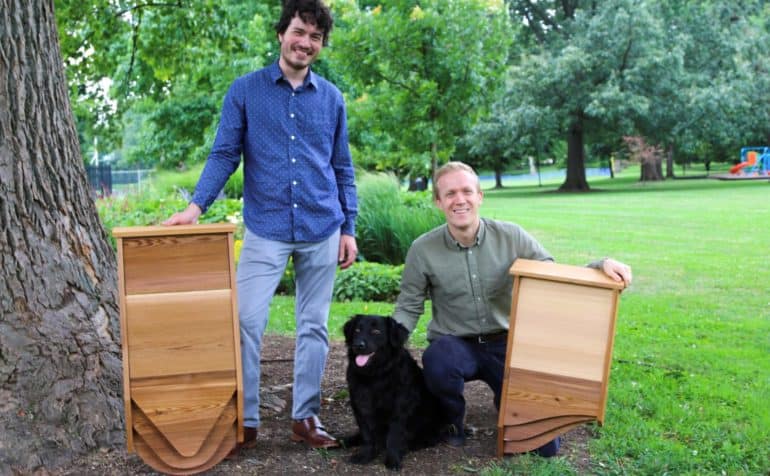Kentucky-based startup BatBnB hopes to help gardeners combat mosquitos and other pests by providing habitat for bats. Through an alternative roost, BatBnB encourages bats’ presence in gardens and fields to prey on undesirable insects and worms.
Bats typically live in caves, mines, rock crevices, tree hollows, plant foliage, and tree bark as well as the roofs of homes, attics, football stadiums, bridges, and artificial bat houses. The BatBnB roost can provide living space when these roosts are in decline or no longer available. The wooden units safely harbor bats when they come out of hibernation and house owners benefit from their instinctive role as pest control.
In exchange for protection from predators, stable temperatures, and safe shelter in which to rest and raise their pups, occupying bats take care of some damaging pests by preying on night-flying insects, moths, mosquitoes, and worms. BatBnB launched the final product line in July 2017 and hopes to raise awareness about bats and their importance for healthy ecosystems.
Food Tank had the opportunity to discuss current solutions to mosquito control and the sustainable alternatives with Christopher Rännefors, co-founder of BatBnB.
Food Tank (FT): What motivated you to start this project?
Christopher Rännefors (CR): My business partner Harrison Broadhurst and I are both planning to start families in the next couple of years, but we also want to travel a lot before we settle down. We worry a great deal about traveling to Zika hot spots around the world because of the impact it could have on our future children as well as our own personal health. When we looked at the market, all we found were more pesticides and chemicals. There were very few good sustainable solutions.
Fortunately, we knew about bats. I grew up building bat houses with my dad, and Harrison learned about bats from his mom’s science classes. We dove into the research and learned more, and that’s when our motivation evolved for the project. Yes, bats eat mosquitoes, but they also eat pests of all kinds and save the U.S. agricultural industry between US$23 billion and US$50 billion in crop damage every year. We wanted to use our respective skills, mine in marketing and entrepreneurship, and Harrison’s in design and architecture, to help raise awareness about bats through a line of designer bat houses which really helps spark the conversation about bats and their value.
FT: Among the eco-friendly solutions to pests, why choose bats?
CR: Bats are amazing pest eating machines, and incredibly misrepresented. Few people know about the impact that bats have on the ecosystem. All they can think about is how scary bats are because they have been brainwashed since childhood with everything from halloween props to vampire TV shows. I bet that the majority of people who are scared of bats have never seen one before—and that’s because bats avoid people. Bats stay out of our way and eat the pests while we are in bed sleeping at night.
FT: What is your target market with this innovation, and which would cause a more lasting impact: domestic users or agricultural firms?
CR: Farms and agricultural firms that love us will care about the landscape, decor, and aesthetic of their properties, but we’re also trying to reach farmers who really want to be serious about seeking alternative solutions to pesticides that are still effective in cutting down on pests. If companies take the time to invest in high-quality expert recommended units like BatBnB, they can house hundreds of bats, re-grow their local bat population, and potentially save thousands of dollars a year on pest control—both in damaged crops and savings from not buying as much pesticide. The product is made from rot-resistant cedar, so will last for many years outdoors without need for replacement. I also think farmers who are interested in eco/agri-tourism will be very interested in BatBnBs to show off to guests as a unique form of natural pest control.
FT: What are some of the biggest challenges for bat pest control?
CR: Misunderstanding bats and not looking at the facts. People fear bats for no good reason. There are already hundreds of thousands of bats living in bat houses all over North America and there isn’t a single recorded case of a bat house owner being attacked by a bat.
And the biggest challenge is that bats are under threat now more than ever. They are dying by the millions, and mother bats only have a single pup every season. That’s why having safe BatBnB homes are so critical for the bats to raise their pups in a comfortable environment.
FT: What are some of the policy changes you would like to see surrounding bat and wildlife conservation?
CR: When we set out on this venture, we were very aware that both Harrison and I are not bat experts. That’s why we partnered closely with Merlin Tuttle, of Merlin Tuttle’s Bat Conservation, an internationally acclaimed bat researcher, and probably the world’s foremost authority on bat houses and bat conservation. He has wholeheartedly endorsed the BatBnB product line. He says ‘the biggest single threat to bats is the major scare campaign in which a few greedy virologists are making sensational claims linking bats as sources of scary diseases in order to divert hundreds of millions of dollars from far higher public health priorities into grants for them to search for new viruses, mostly in bats.’
According to him, ‘we’re increasingly poisoning our food and water as we also kill natural enemies of pests, such as bats. Policies that continue to expand pesticide-dependent and monoculture-farming threaten both humans and bats. Government subsidies that support careless use of wind farms also pose a rapidly growing threat to bats.’
Click here for more information about BatBnB!







